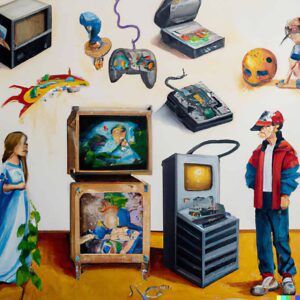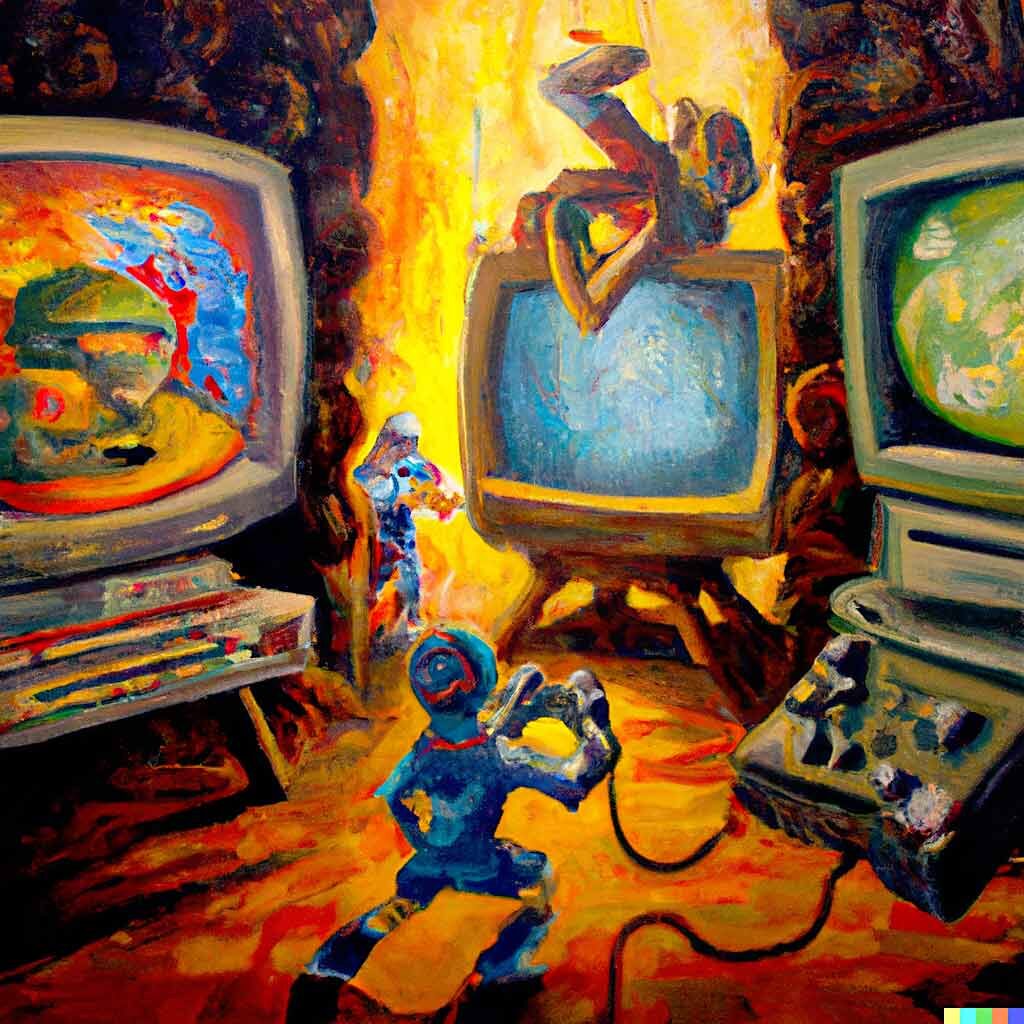- [email protected]
- +353 (0)86 224 0139
- Free Shipping Worldwide
The Evolution of Video Gaming as Art History
As video gaming evolves, is it leaving behind its roots in nostalgia and becoming its own form of art history? Read on to find out and see if you agree!
Reading Time: 20 minutes
TL:DR
- Explore the fascinating journey of video games, from their nostalgic roots to their influential place in modern art history. Discover how this digital medium has evolved into a significant cultural phenomenon.
- Delve into the unique intersection of technology and creativity as we discuss how video games have transformed from simple entertainment to sophisticated expressions of artistry and narrative.
- Uncover the reasons behind the growing recognition of video games in the art world and why they’re not just playthings anymore but an impactful form of artistic expression.
Introduction: Video Gaming From Pixels to Prestige
Video games have become a cultural powerhouse. They’re not just entertainment; they’ve transformed how we experience stories, art, and even social interaction. This relatively young medium, born alongside computers, boasts a multidisciplinary creative process that elevates games to the realm of art.
Over the past few decades, the world of video gaming has exploded, with games becoming more than just a hobby. Today, they’re a respected field of study in art history. But are games truly art? The debate continues. Some argue games are a cultural touchstone deserving artistic recognition. Others see them as nostalgic relics unfit for serious art critique.
Regardless of their artistic merit, video games offer a unique lens through which to explore art history. Their diverse and popular aesthetics provide a gateway to understanding significant artistic movements. Unlike traditional art forms, video games are inherently accessible, making them perfect for mass consumption.
This blog delves into the evolving relationship between video games and art, exploring how games are shaping the artistic landscape.
A Pixelated Past: The History of Video Games
The history of video games charts a unique evolutionary path, unlike any other entertainment form. They’ve become woven into the fabric of art and cultural history, influencing how we play, think, and connect.
This undeniable impact isn’t without its complexities. Video games, like any medium, have sparked debate. While they’ve undoubtedly changed the world, some argue they also come with downsides.
Alan Turing: A Bridge Between Code and Creativity
The history of video games is deeply intertwined with the history of computers. A pivotal figure in this connection is Alan Turing, a brilliant British mathematician and codebreaker.
Turing’s groundbreaking work on algorithms and computation laid the foundation for modern computers. He’s also credited with the Turing test, a thought experiment that explores a machine’s ability to exhibit intelligent behavior. These advancements, while not directly creating video games, paved the way for the development of the complex computing systems that power today’s immersive gaming experiences.
Turing: Codebreaker and Computer Pioneer
Turing’s contributions to the world go far beyond video games. Before World War II, even before the Nazi invasion of Poland, three Polish mathematicians (Marian Rejewski, Henryk Zygalski, and Jerzy Rozycki) cracked the initial code of the Enigma cypher machine. Their work paved the way for British codebreakers like Turing at Bletchley Park, the top-secret Government Code, and Cypher School.
Bletchley Park was shrouded in secrecy. Until the mid-1970s, its members couldn’t discuss their wartime work. Group Captain Winterbotham’s book “The Ultra Secret” (1974) finally lifted some of the veil. This is when Turing’s achievements became known: the code-breaking Bombe machine and Colossus, an early electronic computer.
Turing’s genius extended beyond his wartime efforts. He’s considered a computer science pioneer for defining concepts like algorithms and computation. His “Turing test” is a benchmark for a machine’s ability to exhibit intelligent behaviour.
Post-War Innovations
After WWII, Turing’s work continued at the National Physical Laboratory, where he helped create the ACE (Automatic Computing Engine), an early design for the modern computer. He then became Deputy Director at the University of Manchester’s Computing Machine Laboratory, working on software for the Manchester Mark 1, another early stored-programme computer. This work undeniably influenced the development of video games.
Sadly, during this time, homosexuality was illegal. In 1952, Turing was convicted and forced to undergo chemical castration to avoid prison. This revoked his security clearance, ending his government consultancy.
A Legacy of Progress
In 2013, Turing received a posthumous royal pardon. Today, he’s celebrated for several reasons:
- A Role Model for Equality: The LGBTIQA+ community honours Turing for his contribution to diversity and inclusion.
- A Lasting Impact: The codename for Nvidia’s 2018 graphics processing unit (Turing) and the Alan Turing £50 banknote (issued in 2021) are testaments to his influence.
Turing’s story is more than wartime codebreaking. He’s a pioneer whose work on early computers, including those developed at the Universities of Manchester, Cambridge, Pennsylvania, and Princeton, laid the foundation for the digital revolution. These early stored-programme computers paved the way for companies like Remington Rand, Ferranti, and IBM to commercialise computers in the 1950s, forever changing the world.
Early Video Game Pioneers
The history of video games stretches back further than you might think! Here are some of the first innovators in the field of computer games development:
- 1950s: Josef Kates’ “Bertie the Brain” (1950) for the Canadian National Exhibition is considered the first computer game, even though it used lights instead of a screen.
- 1952: Christopher Strachey’sgames, OXO and draughts, were the first with electronic visuals.
- 1958: William Higinbotham’s “Tennis for Two” wasn’t a technological leap, but it was the first purely for entertainment.
Spacewar!: The Early Multiplayer Hit (1962)
Created by Steve Russell and his team at MIT, “Spacewar!” holds the title of the first video game played on multiple computers. This collaborative effort sparked a wave of innovation.
Pong: The Arcade Breakout (1972)
Atari’s “Pong” isn’t the first video game, but it’s one of the first major commercial successes. Designed by Allan Alcorn, it brought video games to a wider audience.
The Oregon Trail: Learning Through Play (1971)
Created by educators, “The Oregon Trail” (1974) wasn’t just for fun. It taught students about the challenges of pioneer life in the 1800s. Players took on the role of waggon leaders, guiding settlers on a difficult journey westward.
Jerry Lawson: The Father of the Game Cartridge (1940–2011)
American engineer Jerry Lawson led the team that developed the first commercially viable video game cartridge system for the Fairchild Channel F (1976). Though not an initial success, this technology paved the way for future consoles, such as the Atari 2600, which was subsequently released in 1977. Lawson later founded his own video game company, Video-Soft.
The Evolution of Video Games into Art
Video games have come a long way since their early days as simple pixelated games. Today’s video game industry is big business, with high-budget, high-profile AAA games typically produced by major publishers. Developing these big-name games can take around four years and cost over $80 million.
As gaming technology has advanced, so too has developers’ artistic abilities. Talented creators in the industry are highly skilled artisans who have honed their specialties. Some may be considered commercial artists, working within an established franchise or movie universe.
Many modern video games are now considered works of art, featuring beautiful graphics and complex narratives. Some argue games are evolving from nostalgic novelties into art history. Whether you agree or not, games are increasingly recognized as art, not just entertainment.
This is evident in art’s influence on game design – from scene lighting to 3D modeling and animation. Stories and plots also draw inspiration from classic art and literature. As games continue to evolve, their status as art will likely grow.
Are Video Games Art? – It is Becoming Harder to Deny
In the past decade, video games have become a much more mainstream form of media. Whether its films, music, television shows, or comic books, digital technology has revolutionised the world of entertainment. While films, music, and television have always been popular, video games have remained distinctive in their aesthetic space from the rest of the media world.
Some prominent critics were doubtful, including Roger Ebert, a notable American cinema critic, film historian, journalist, screenwriter, and author. He was critical of not only the resurgence of 3D effects in film, which he saw as unrealistic and obtrusive, but also of video games.
In 2005, Ebert stated that video games are not art and are inferior to media developed through authorial control, such as film and literature, noting, “video games can be elegant, subtle, sophisticated, challenging and visually wonderful,” but “the nature of the medium prevents it from moving beyond craftsmanship to the stature of art.”
This sparked a backlash from video game fans, including novelist Clive Barker, who defended video games as an art form.
Video games, as an art form that has only existed in the digital realm, are truly a synthesis of art and science. Many traditional forms of artistic expression, such as:
- traditional artwork;
- traditional animation, in addition to:
- digitisation of analog data sources into digital files;
- Rotoscoping a technique used by animators to trace over motion picture footage frame by frame to create realistic action;
- motion capture animation;
- narrative arcs;
- dynamic music;
- 3D modelling and sculpting.
This combination of the techniques above results in producing something that transcends any single genre. In many ways, I view video games as the most powerful form of conceptual art, in which the concept or idea involved in the work take precedence over traditional aesthetic, technical, and material concerns.
The Aesthetic of Video Games
Video games are an art form, and one that has developed significantly over the years. From the first arcade machines to the wildly popular mobile gaming apps, video games have come a long way since the first Pong was released in the early 1970s.
The aesthetics of early video games were a product of technology. Contemporary games, on the other hand, are based on a conscious choice of art style, enabled by powerful graphic processing units (GPU), which trick our eyes with ever realistic and immersive graphics.
Today, there are hundreds of video games being developed and released every year, each with a different story, setting, or theme. However, while video games are evolving, they are still heavily influenced by the medium’s history. Throughout the evolution of video games, their design has been influenced by everything from film to architecture.
“An oil painting of Are Video Games Evolving From Nostalgia To Art History?”
Adrian × DALL·E
Human & AI
2022
The Psychology of Video Games
In our increasingly computer-obsessed world, video games have become one of the most popular forms of media. If you consider yourself a gamer, you undoubtedly spend hours upon hours in front of your screen. Just one more go, frantically bouncing between levels and attempting to beat your previous high score.
This is almost certainly a common experience, whether you are an avid player or a casual observer. Nevertheless, why do we love games so much? Moreover, what are they doing to us?
Why We Love Them
Video games have become more than just a hobby for many players. They are an outlet for inspiration, a break from reality, and a way to escape their everyday lives. Whether it is an escape from the real world or an opportunity to explore new cultures and ideas, video games offer a unique experience that should not be overlooked.
Many gamers obsessively replay old simulators and adventure games, just as you might do with an old book or a song whose lyrics are familiar from their childhood.
Video games can be viewed as both nostalgic and modern objects for the generation(s) that grew up with them. In addition, as vehicles for nostalgia since they are a medium that can elicit memories of the past.
According to prominent video game scholars, “video games give a unique setting within which to investigate nostalgia because they hold connotations with childhood, technology, and technological change, as well as the effect of preceding forms of media.”
Additionally, games are more immediate and personal than other forms of entertainment due to their immersion factor. Players remember when they defeat the bad guy, not when they see a movie about a hero defeating the bad guy.
Well-Being
Video games have been around for a while, and they are not going anywhere. In fact, they are becoming more and more popular with each passing year. Nevertheless, what are the implications of this?
This question has puzzled many psychologists, sociologists, and parents alike. In order to gain a better understanding of how video games affect our well-being, we can explore a few theories. Past research suggests people whose psychological needs were not being met in the “real world” might report negative well-being from play.
Excessive video game play is now recognized as an addiction disorder by the World Health Organization, though the criteria does not include a specific number of hours spent playing.
Instead, the description is of someone who is unable to stop playing despite the fact that it interferes with other aspects of their life, such as family relationships, school, work, and sleep. Fortunately in most cases, these problems would need to last at least a year before being diagnosed.
What Video Games Are Doing to Us
Video games have long been a part of our lives, and people are playing them more than ever. They provide us with entertainment and a way to escape reality, but many people are concerned that this activity is harmful.
Many previous studies have attempted to demonstrate how video games affect our mental health and well-being, but they rely on self-reported play behaviour. Furthermore, these studies frequently lacked adequate data to determine whether these concerns were justified.
In 2021, Oxford University published a report in collaboration with Electronic Arts and Nintendo of America. This study obtained actual play behaviour from players for the following games:
- Plants vs. Zombies: Battle for Neighborville
- Animal Crossing: New Horizons
Gamers were polled about their overall well-being, motivations, and need for satisfaction while playing, and their responses were combined with telemetry data. The study discovered a small positive relationship between game play and affective well-being, contrary to popular belief. Need satisfaction and motivations during play did not interact with playtime, but were instead related to well-being independently.
The study demonstrated that collaborations with industry partners could be carried out in an ethical and transparent manner while upholding high academic standards. Furthermore, the study provided policymakers with much-needed evidence about the relationship between play and mental health.
What Psychological Impact Do Games Have on Their Players?
Video games have always been a contentious subject. Many people believe that video games are harmful to your health, while others believe that they can be beneficial and even therapeutic. The psychological short- or long-term effects of video games on their players, on the other hand, are still not fully understood.
Not only can video games provide a reprieve from the daily grind, but they have also been shown to boost cognitive performance. When we play video games, our brains release serotonin, which gives us a sense of accomplishment when we complete difficult tasks.
Having a higher feeling of self-efficacy, or believing that one can do things successfully can enhance motivation. Additionally, cognitive skills such as spatial reasoning, memory, and attention span can also improve.
Others suggest that playing video games may actually improve your mental health by lowering stress and anxiety levels. For some, it serves as a distraction from pain and psychological trauma.
Additionally, video games can provide connections for individuals who struggle in social situations or do not have other means to interact with others. This has been shown to be true for children with autism spectrum disorder or those who live alone.
On the other hand, there have been concerns that video games may increase violence in society or lead to addiction in players. These questions will help us better understand the world of video games and their influence on society. From their positive effects and emotional resonance to moral considerations, games have challenged our decision-making and changed the way we interact.
Video Games for Mature Audiences
We are not discussing the content rating here, but because video games are such a new medium, they have only recently begun to mature over the last couple of decades. As a result, it will be interesting to see what kinds of games are developed for an older gaming audience.
As gamers age, games may contain fewer physical and mental activities with a low impact. They require players to make decisions about situations, to be creative, and to perform memory exercises. These games are also easy to learn, have bright, bold graphics, and require good coordination.
The Impact of Video Games on Society
It was not until the 1970s and 1980s that video games took off as an industry. Space Invaders, Pac-Man, and Nintendo’s Game & Watch signalled the beginning of a new era of video games. These and many other games have evolved and influenced culture, art, and entertainment.
Back in the day, computer magazines frequently published code so that readers could copy it and acquire a free game. I recall typing out lines and lines of code for a free game that would run on my father’s Commodore Vic-20. The Vic-20 was the first computer of any description to sell one million units, but more importantly, ours had the 3.5K RAM expansion pack! To put that in context, the smartphone in our pocket has thousands upon thousands of times the power.
However, I was always a little disappointed that the result fell short of the beautiful artist illustrations or cover art that accompanied the code. Lines and lines of text, numbers, symbols and signs that did not make any sense to me.
I remember reading about how future games would become more photorealistic, which was something I could only dream of at the time.
Nonetheless, video games enable us to express ourselves, tell stories, and capture a specific moment in time. For example, Rockstar Games’ 1997 release of Grand Theft Auto is widely regarded as ushering in a gaming revolution.
The game offered a bitingly critical look at contemporary American life; some regard it as one of the most important and influential titles of all time. Despite being banned in a number of countries and heavily criticized by many groups for its portrayal of negative emotion and violence, it is widely regarded as a game changer and social commentary.
Oscar Wilde once wrote that “Life imitates art far more than art imitates Life.” Tony Hawk’s Pro Skater (THPS) series, on the other hand, influenced a new generation of skaters. People who had never skated before were soon sharing their favorite “trick” button combinations. Not only that, but a group of skateboarding enthusiasts recreated the video game series in real life.
It is no secret that video games are an important part of our culture and, for many people, have become a way of life.
The Popularity of Retro Video Games
Retro video games are a popular phenomenon, with many gamers nowadays reliving the glory days of gaming through collectible consoles and beloved older games. Some of these games are exclusive to older consoles, but some are being remastered for newer consoles.
Small single-board computers, such as the Raspberry Pi, can run retro game emulation software. This allows individuals without the appropriate hardware and software the accessibility to experience gaming history and indulge their nostalgia.
The popularity of retro video games has been steadily on the rise for the past few years. Not only because of nostalgia and aesthetics, but also because the majority of people who grew up playing these games now have disposable income. Many retro video game stores offer many second hand bargains and increasingly valuable rare items for the serious collectors alike.
Video gaming history is an interesting subject because it tells us about how far gaming has come in such a short span of time. It also tells us about how digital games are different from their predecessors and how they are influencing our culture in various ways.
Nostalgic aesthetics make old consoles more appealing to players because they evoke childhood memories. Video arcades also contribute to this nostalgic aesthetic as they remind players of the old days when video gaming was not so accessible at home.
The Resurgence of Pixel Art
Pixel art is a type of digital art created with graphical software in which images are constructed entirely from pixels. Pixel art is particularly relevant in the world of video games, as 24% of the best-selling games of all time employ this art style.
It is commonly associated with low-resolution graphics from 8-bit and 16-bit era computers and arcade video game consoles. Pixel art is distinguished by its low overall colour count. Pixel art as a medium is similar to early video game graphics, which were created by devices that could only output a limited number of pixel colours such as LED displays and graphing calculators.
Furthermore, many pixel artists believe that using a large number of colours, especially when they are relatively similar in value, is superfluous in most cases and detracts from the overall cleanliness of the image, making it appear messier.
Even though technological limitations have since been overcome, pixel artists and game studios continue to use the art form.
The past few years have seen a resurgence of pixel art in video games, and it is not hard to see why. There is something about the limitations of working with limited colours and pixels that makes projects much more interesting and creative. Pixel art is enjoying a sort of newfound popularity, with many modern games using retro aesthetics and themes.
When I first saw Minecraft, I could not believe how popular it was, in terms of its graphics, I thought it was going backwards. However, devoid of any visual nostalgia, pixel art was something completely new to the next generation of gamers.
By watching my daughter play, I realised how sophisticated the game was, and it reminded me of playing with Lego when I was younger. In the future, I expect we will see some very creative, spatially aware architects and urban planners.
Remakes
The original The Last of Us was published on the PlayStation 3 in 2013 and then remastered a year later for the PlayStation 4. Less than a decade after its initial release, the game is being remade with the new title “The Last of Us: Part I” for the PlayStation 5. This will help to market the franchise to a new audience as it moves to television as a planned HBO series.
Why Are Video Games Becoming More Than Just Nostalgia?
The video gaming industry is huge and has become an important part of our culture. In the last few years, the revenues of the video game industry have been larger than the film industry.
For some, video games have evolved from a pastime activity to a lifestyle, from YouTubers to professional e-sports players. The number of people playing video games on a daily basis is increasing, with the average gamer playing for six hours each week. Furthermore, non-traditional gamers like women and older people becoming more and more prevalent.
Since the release of Pong in 1972, video games have come a long way. Initially, they were just a way to escape reality and forget about life for a while, but they have evolved into much more. They are an art form, a business, and even a tool for education.
Second-hand Nostalgia from Cultural Memory
The term “nostalgia” comes from the Greek word nostos, meaning “return home,” and algia, meaning “pain.” In the past, nostalgia was used to describe a physical illness. However, in the late 18th century, nostalgia was redefined as a psychological condition.
Nostalgia is a powerful emotion usually associated with memories of family, friends, or life events that evoke feelings of happiness and comfort in people. Furthermore, restorative nostalgia sees the past as a place of truth rather than longing. Reflective nostalgia, on the other hand, considers questions of belonging and heritage while avoiding the ambiguities of modern society.
In contrast, second-hand nostalgia occurs when someone who has not experienced something personally, feels nostalgic for it. Often, this is only because they have heard about or seen it before.
This type of nostalgia can be found in video games, where people feel nostalgic for something they have never experienced themselves. Such as, playing an old arcade game, or feeling nostalgic for late-20th-century video gaming culture.
However, these emotions can also be a powerful marketing tool that can be used to get people to buy products. From the early days of arcades, when games like Pac-Man and Space Invaders were released, to the modern era of video gaming consoles. Additionally, the media mediate memories for the millennium generation via shows like Stranger Things.
As time goes on, the video gaming industry will continue to use nostalgia as a way to keep consumers interested in their products.
Preserving the History of an Art Form
Many museums that have held video game exhibitions have addressed the question of whether video games should be considered art and included in the history of art. These exhibits will explore how games are different from other modern forms of media. This post aims to support the argument that video games are becoming art.
The BAFTA Games Awards, also known as the British Academy Games Awards, are a British awards ceremony that recognizes “outstanding creative achievement” in the video game industry each year. The first BAFTA Games Awards were held in 2004, rewind time if you have not played any of the classic games on the list yet, this is a good place to start.
Some of My Favourite Video Games
With so many prolific games to choose from, it would be impossible to list all of my favourite computer games. The following non-exhaustive list in alphabetical order is an appreciation of the art and game-play with the nostalgic memories of hours spent enjoying them.
Bioshock – 2003 Ken Levine created the BioShock video game series, which was published by 2K Games and developed by several studios, including Irrational Games and 2K Marin.
Platfoms: Microsoft Windows, Xbox 360, PlayStation 3, Mac OS X, iOS
Fez – 2012 Fez is an indie puzzle-platform game released in 2012 by Trapdoor and developed by Polytron Corporation. Gomez, the main character, is given a fez that reveals his two-dimensional world to be one of four sides of a three-dimensional world. The team comprised composer Rich Vreeland, designer Phil Fish, sound designer Brandon McCartin, programmer Renaud Bédard.
Platforms: Xbox 360, Windows, Linux, OS X, PlayStation 3, PlayStation 4, PlayStation Vita, iOS, Nintendo Switch
Half-Life – 1998 Half-Life is a first-person shooter game series created and published by Valve. The games mix shooting, puzzles, and storytelling. Valve’s first product, Half-Life, was released in 1998 for Windows to critical and commercial success. I still vividly recall being astounded by The Orange Box, a 2004 video game collection featuring five games created and released by Valve. In addition to Half-Life 2, it included Team Fortress and the amazing Portal, all of which were included on many gamers’ “best of” lists.
Platforms: Windows, MacOS, Linux, Xbox, Xbox 360, PlayStation 2, PlayStation 3, Shield Portable
Monster Max – 1994 Monster Max is an isometric adventure video game developed by Rare and published by Titus France. In 1994, it was released for the Game Boy handheld game console.
Platforms: Game Boy
Ōkami – 2006/7 Ōkami is set in classical Japan; it combines Japanese mythology and folklore to tell the story of how Amaterasu, the Shinto sun goddess, took the form of a white wolf to save the land from darkness. Featuring a cell-shaded visual style inspired by Sumi-e, a Japanese ink painting wash technique, and Celestial Brush, a gesture system for enacting miracles.
Platforms: PlayStation 2, Wii, (Ōkami HD: PlayStation 3, Microsoft Windows, PlayStation 4, Xbox One, Nintendo Switch, Amazon Luna).
Portal – 2004 As I previously mentioned, Valve’s original game, Portal, was released in 2004, as part of The Orange Box. A first-person puzzle-platformer set in the Half-Life universe, the two main stand-alone games in the series, Portal (2007) and Portal 2 (2011), centre on a woman, Chell, who is forced to undergo a series of tests within the Aperture Science Enrichment Center by a malicious artificial intelligence, GLaDOS, who controls the facility.
Platforms: Windows, PlayStation 3, Xbox 360, Mac OS X, Linux, Android, Nintendo Switch
Speedball 2: Brutal Deluxe – 1990 A video game based on a violent futuristic cyberpunk sport that borrows elements from handball and ice hockey and rewards both violent and goal-scoring play. Speedball 2 was more popular and enduring than Speedball, and it has been remade and republished numerous times.
Platforms: Acorn Archimedes, Atari ST, Amiga, Amiga CD32, Commodore 64, PC, Sega Master System, Game Boy, Game Boy Advance, Sega Mega Drive, Windows Mobile, PlayStation, Xbox 360, iPhone, Symbian
The Unfinished Swan – 2012 The Unfinished Swan begins in a completely white space, with the player, a boy named Monroe (voiced by Nicholas Marj), chasing after a swan that has escaped from a painting while learning the story of a lonely king (voiced by Terry Gilliam).
Platforms: PlayStation 3, PlayStation 4, PlayStation Vita, Microsoft Windows, iOS
XIII – 2003 XIII is a first-person shooter video game based on the first five volumes of the same-titled 1984 Belgian graphic novel series. It is a fantastic-looking game presented in a comic-book-style, cell-shaded style.
Platforms: PlayStation 2, GameCube, Microsoft Windows, MacOS, Xbox
Exploring the Artistic Elements in Video Games: The Emotional Journey of “Flower”
- Video Game Design as an Art Form: In the realm of video gaming, there exists a masterpiece that exemplifies the artistic elements within the medium: “Flower.” The game’s creator, Chen, took a unique and innovative approach to evoke a profound emotional response in players, challenging traditional notions of gameplay and design.
- Crafting Emotional Experiences: Chen believed that video games should transcend mere entertainment and aim to elicit specific emotional responses from players. With a meticulous eye for detail, the development team intentionally removed gameplay elements and mechanics that didn’t contribute to the desired emotional journey. This deliberate artistic choice transformed “Flower” into a captivating work of interactive art.
- The Power of Emotional Response: One of the key goals of video game design is to evoke a deep emotional response. In “Flower,” this objective was achieved through simplicity and subtlety. By embracing minimalistic gameplay mechanics and focusing on evoking positive emotions, the game successfully transported players on an emotional journey unlike any other.
- Dynamic Design and Music: To further enhance the emotional experience, the game’s design seamlessly integrates with the dynamic music composed by Vincent Diamante. The music responds to the player’s actions, creating a harmonious symphony of emotions that intensifies the overall gameplay experience.
- Critical Acclaim and Recognition: “Flower” surpassed all expectations, receiving widespread critical acclaim. Reviewers praised its ability to evoke genuine emotional responses through its artistic design, visuals, and immersive gameplay. The game became a remarkable testament to the power of video games as an artistic medium. It garnered numerous awards, including the “Best Independent Game of 2009” at the Spike Video Game Awards, solidifying its status as a groundbreaking work of art.
- Expand Your Perspective on Art in Video Games: If you are captivated by the artistic elements in video games, “Flower” serves as a splendid example of how emotional responses can be masterfully crafted in interactive experiences. Explore my blog page dedicated to “Paintings of Flowers” to delve even deeper into the captivating world of art and its various forms of expression.
Which Game Has Yet To Be Invented?
The video game industry is continuously evolving, so it is not surprising that we do not know what games will be like in the future, but what if we could. The Entertainment Software Association organizes and presents E3, a trade show for the video game industry. Developers, publishers, hardware manufacturers, and accessory manufacturers use it to promote upcoming games and game-related merchandise to retailers and the media.
Is it possible to uncover new game concepts by researching the psychology of gamers and how they react to various stimuli? This could be explored in tandem as well as the societal changes that are taking place at the same time.
The idea might be to introduce something physical that can be played while complementing the allure of sitting in front of a TV. Children today have access to extremely powerful smartphones with internet access, maps, GPS, and Bluetooth technology. This creates ideal conditions for a wide range of activities, from advanced tag games to distributed team sports or even global education and learning.
Athletes tend to dominate regular sports; if you have different abilities from your teammates, you just will not have as much fun. Different types of roles can be defined by defining the rules differently, allowing for a greater diversity in who is qualified to participate.
What about sports that combine the outcomes of real-world matches and digital teams, the results of which would dynamically change?
Some of the issues that game design could help to solve in sports are as follows:
- aids the gender neutrality of the new sport;
- lowering the entry barriers;
- using virtual and augmented reality to adapt to a more urban situation;
- Teamwork is valued by others and is one of the most rewarding and difficult aspects of team sports and activities.
However, one of the issues here is that it is not always a level playing field across the globe. As in the physical world, many in developing countries may not have the same access to technology or level of opportunity. Not only that, but also this is before you consider factors such as the developed world’s air of entitlement or conscientious bias.

Conclusion: The Future of Gaming is Bright and Full of Possibilities
We discussed video games’ cultural and historical perspectives in this blog post, including their characterisation in history and their impact on society. In addition to being a simple pastime, video games have become an integral part of our culture.
Video games present a complex topic, with a variety of implications for both positive and negative impacts on society. Nevertheless, their importance and relevance to our culture and history cannot be denied. They help us tell the stories of our time and explore the world of our imagination.
My blog on whether or not video games are “art” has been and continues to be a source of contention. The real question, perhaps, should be, “What is the true measure of art?” While not everyone accepts video games as art, there is no denying that they contribute significantly to artistic media such as music and film.
I, for one, believe that video games are art, just as any medium that elicits emotions or provides an experience is. Such as the first time I played Journey, an indie adventure game with a wordless story told through game-play and visual cut-scenes. Some could be even considered games to improve emotional intelligence.
Video games have evolved from a derivative medium that drew inspiration from other art movements and types of media, such as literature, films, and music. Today, it has become a type of medium from which other types derive new ideas. Video games have also interacted with traditional forms of media, altering them and introducing new forms of entertainment and interaction.
One of the things that sets video games apart from other media is their unique narrative and artistic style. A common misconception about video games is that they are purely entertainment. Nevertheless, video games have evolved into something that critics and art historians can study.
As video gaming evolves, it is clear that nostalgia is no longer the only driving force. Art history is playing an increasingly prominent role in the medium, with developers using classic works as inspiration for their own creations.
For example, Pentiment, which means an earlier painting covered up by a later one, was released in November 2022. It is a narrative adventure game with a Renaissance-style aesthetic inspired by illuminated manuscripts, woodcut printing, and publications such as the “Nuremberg Chronicle.”
I do not have as much time to play video games as I used to. I do, however, enjoy keeping up with the most recent and inventive games on the market. Finally there is no reason why modern game design cannot be used as an inspiration when creating artwork. I hope that this has helped to spark a debate in your mind.
If you enjoyed this article, please show your support by subscribing to my mailing list and sharing it with your network! As an independent artist, your support means the world to me. Your time is valuable, and I appreciate you taking the time to read my blog.
Don’t miss out on future articles and updates – subscribe now and stay connected!
FAQ
What Was the First Example of a Video Game?
In 1950, the first publicly demonstrated electronic game was created. Josef Kates created Bertie the Brain, a tic-tac-toe arcade game, for the 1950 Canadian National Exhibition.
Learn more about early electronic games by reading on.
How Have Video Games Changed Over the Years?
The development of game cartridges that stored games and could be swapped in the system was a key step forward in the evolution of video games. The Atari 2600, first introduced in 1977 as the Atari Video Computer System (Atari VCS), popularised microprocessor-based hardware and swappable ROM cartridges.
With this technology, consumers were no longer confined to a specific amount of games, forcing many video game console manufacturers to turn their priority to game production.
The real gaming revolution occurred when LAN networks, and later the Internet, made multiplayer gaming possible.
In spite of the fact that physical video game stores still exist, online video game stores are experiencing a surge in sales.
Which Video Games Are the Most Iconic?
The following iconic titles are often cited as having a major impact on society and culture, and will undoubtedly leave an impact on future generations of gamers and creators.
In alphabetical order:
- Assassins Creed
- Bioshock
- Call of Duty
- Doom
- Final Fantasy VII
- God of War
- Grand Theft Auto
- Lara Croft – Tomb Raider
- Minecraft
- Need for Speed
- Pac-Man
- Resident Evil
- Street Fighter II
- Super Mario Bros
- Tetris
- The Last of Us
- The Legend of Zelda
- The Sims
- Wii Sports
What Are the 3 Most Successful Video Games of All Time?
In terms of number of copies sold, these are the top three games:
- Tetris – 520 Million
- Minecraft – 238 Million
- Grand Theft Auto V – 170 Million
The 23 Best Video Game Documentaries
In alphabetical order, here are the 23 Best Video Game Documentaries:
- All Your History Are Belong To Us
- Atari: Game Over
- Console Wars
- Double Fine Adventure
- FGC: Rise of the Fighting Game Community
- From Bedrooms to Billions: The PlayStation Revolution
- G4 Icons (TV Series)
- GameLoading: Rise of the Indies
- God of War: Unearthing the Legend
- Grounded: The Making of The Last of Us
- High Score
- Indie Game: The Movie (Super Meat Boy, Fez, Braid)
- Minecraft: The Story of Mojang
- Naughty Dog 30th Anniversary Documentary
- Noclip Final Fantasy Doc
- Rise of the Video Game
- Super Game Jam
- Thank You For Playing
- The Art Of The Game
- The King Of Kong: A Fistful Of Quarters
- The Lost Arcade
- Video Game Invasion: The History of a Global Obsession
- World of Warcraft: Looking for Group
Thrall to the Algorithm
This piece is perfect for any art lover who wants to add a touch of sophistication to their life. This artwork is ready to hang and is perfect for any room in any location.
Adrian Reynolds, or ‘Ren,’ is a Dublin-based contemporary artist. His works are a reaction to the world around us. A world that continues to evolve quicker than ever. His work investigates colour, form, and texture, putting them at the intersection of abstraction and representation. His art has been shown in Ireland, the United Kingdom, and the United States.
Latest Artwork
-
Bullets Travel Distance & Time
Abstract Art Paintings €1,000.00Add to basketBullets Travel Distance & Time | Acrylic Painting By Adrian Reynolds
-
The Perception of Narrative
Abstract Art Paintings €800.00Add to basketThe Perception of Narrative | Fine Art Acrylic Painting By Adrian Reynolds
-
Iridescent Dream
Abstract Art Paintings €240.00Add to basketIridescent Dream | Acrylic Painting By Adrian Reynolds
-
Blue Nebula
Abstract Art Paintings €240.00Add to basketBlue Nebula | Acrylic Painting By Adrian Reynolds





